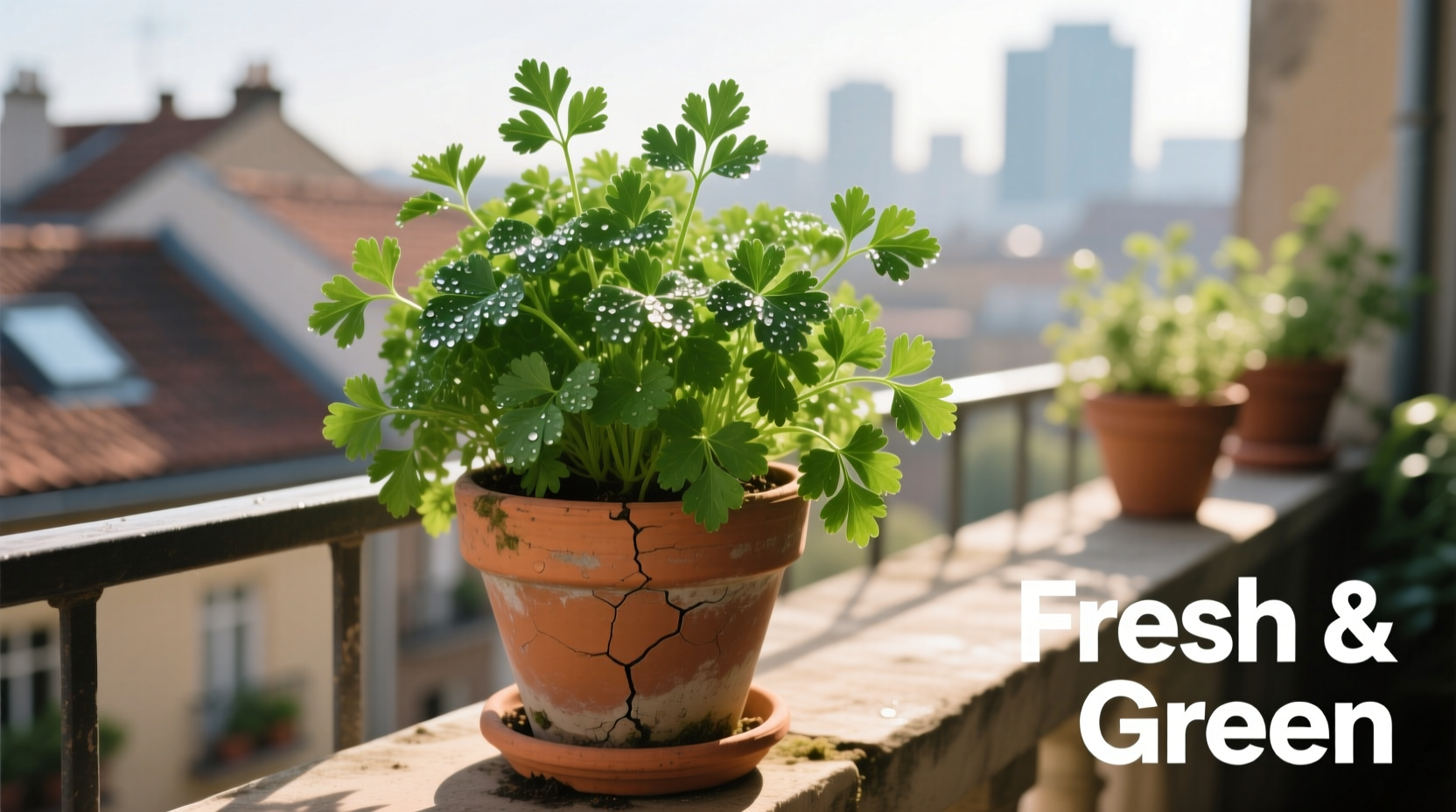Why Container Gardening Works Perfectly for Parsley
Container gardening transforms parsley cultivation from a seasonal activity to a year-round fresh herb supply. Unlike garden beds, containers give you complete control over soil conditions, moisture levels, and placement—critical factors for parsley's success. This versatile herb adapts exceptionally well to container life when you understand its specific needs. Whether you have a sprawling patio or just a sunny windowsill, you can harvest crisp, flavorful parsley leaves within 70-90 days from seed.

Your Container Selection Checklist
Choosing the right container makes or breaks your parsley-growing success. Most beginners underestimate how much root space parsley needs, leading to stunted growth and bitter leaves. Follow these specifications for optimal results:
| Container Type | Best For | Drainage Rating | Maintenance Tip |
|---|---|---|---|
| Terracotta pots | Dry climates | ★★★★☆ | Soak before planting to prevent moisture absorption |
| Plastic containers | Indoor growing | ★★★☆☆ | Add extra drainage holes for better aeration |
| Self-watering pots | Busy gardeners | ★★★★★ | Clean reservoir monthly to prevent algae buildup |
| Fabric grow bags | Preventing root circling | ★★★★☆ | Place on tray to catch excess water |
According to the USDA Agricultural Research Service, parsley roots grow vertically up to 12 inches deep. Select containers with minimum 6-8 inch depth to accommodate this growth pattern without constriction. Shallow containers cause roots to circle and become rootbound, reducing leaf production by up to 40%.
Soil Science for Thriving Container Parsley
Container soil requirements differ significantly from garden beds. The University of Minnesota Extension confirms that container herbs need soil with superior drainage yet moisture retention capabilities. Create this ideal balance with:
- 60% high-quality potting mix (never garden soil)
- 30% coconut coir or perlite for aeration
- 10% compost for slow-release nutrients
Maintain soil pH between 6.0-7.0 using a simple $5 meter—critical for nutrient absorption. Acidic soil below 5.5 prevents iron uptake, causing yellowing leaves. Test monthly during growing season and adjust with garden lime to raise pH or elemental sulfur to lower it.
Parsley Variety Selection Guide
Not all parsley varieties perform equally in containers. Consider these growth characteristics when selecting seeds:
| Variety | Container Suitability | Maturity Time | Flavor Profile |
|---|---|---|---|
| "Titan" Italian parsley | ★★★★★ | 75 days | Strong, clean flavor |
| "Petroylanski" flat-leaf | ★★★★☆ | 85 days | Sweet with subtle pepper notes |
| "Forest Green" curly | ★★★☆☆ | 90 days | Milder, decorative leaves |
Watering Techniques That Prevent Common Failures
Improper watering causes 70% of container parsley failures according to Oregon State University Extension. Follow this precise watering protocol:
- Morning watering: Water between 6-9 AM when temperatures are cooler
- Soil check: Insert finger 1 inch deep—water only when top layer feels dry
- Water volume: Apply until 10-15% drains from bottom holes
- Frequency adjustment: Water every 2-3 days in summer, weekly in winter
Use room-temperature water to avoid shocking roots. Cold water below 60°F (15°C) slows growth significantly. During heatwaves above 85°F (29°C), mist leaves in the evening to increase humidity without saturating soil.
Fertilizing Schedule for Maximum Leaf Production
Container parsley depletes nutrients faster than garden-grown plants. Implement this science-backed feeding schedule:
- Weeks 1-4: No fertilizer (seed starting mix contains sufficient nutrients)
- Weeks 5-8: Half-strength liquid seaweed every 14 days
- Weeks 9-12: Balanced 5-5-5 organic fertilizer weekly
- Ongoing: Alternate between fish emulsion and compost tea
Over-fertilizing creates excessive nitrogen that produces dark, bitter leaves. The Royal Horticultural Society recommends stopping all fertilization 3 weeks before harvest for optimal flavor development.
Harvesting Methods That Extend Productivity
Proper harvesting techniques can extend your parsley container garden's productivity by 3-4 months. Follow these professional chef-recommended practices:
- Wait until plants have 10-15 leaves (3-4 leaf sets) before first harvest
- Snip outer stems at soil level using sharp scissors
- Never remove more than ⅓ of the plant at one time
- Harvest in morning when essential oils are most concentrated
- Regular harvesting encourages bushier growth and delays bolting
Container-grown parsley typically produces for 6-8 months before declining. When growth slows, cut plants back to 2 inches above soil line to stimulate new growth. This technique, called "hard pruning," often extends container parsley productivity through two growing seasons.
Troubleshooting Common Container Problems
Identify and solve these frequent container parsley issues before they become serious:
| Symptom | Likely Cause | Solution | Time to Recovery |
|---|---|---|---|
| Yellow lower leaves | Nitrogen deficiency | Apply diluted fish emulsion | 7-10 days |
| Wilting despite wet soil | Root rot | Repot with fresh soil, trim damaged roots | 2-3 weeks |
| White powdery coating | Powdery mildew | Spray with 1:10 milk-water solution | 5-7 days |
| Stunted growth | Rootbound container | Transplant to larger pot immediately | 10-14 days |
Season Extension Strategies
Container parsley doesn't have to end with the first frost. Implement these techniques to enjoy fresh parsley year-round:
- Fall transition: Move containers indoors 2 weeks before first frost
- Winter lighting: Provide 12-14 hours of full-spectrum light daily
- Temperature control: Maintain 60-70°F (15-21°C) for optimal growth
- Humidity boost: Place pots on pebble trays filled with water
- Spring revival: Gradually reintroduce to outdoor conditions over 10 days
When growing parsley indoors during winter, reduce watering frequency by 30% and fertilize half as often. Indoor plants grow slower due to reduced light intensity, so adjust care accordingly to prevent root rot from overwatering.











 浙公网安备
33010002000092号
浙公网安备
33010002000092号 浙B2-20120091-4
浙B2-20120091-4